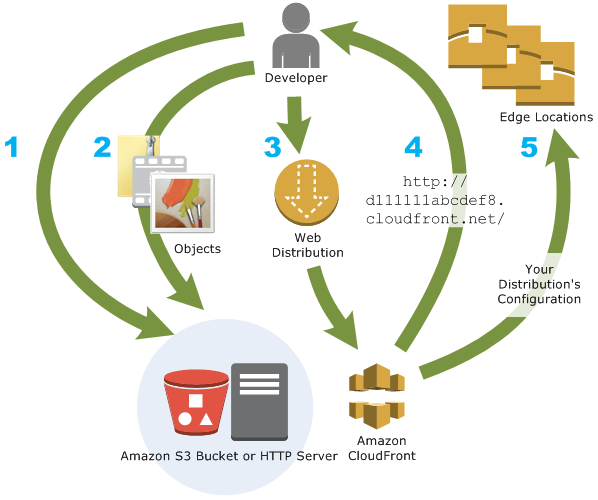Amazon CloudFront is a content delivery service that works in conjunction with other Amazon Web Services (AWS) to make it simple for developers to transmit information to end-users. CloudFront has features similar to dynamic site acceleration, which is an approach for boosting online content delivery, but it can’t modify the structure of the content, such as shrinking files or converting images to sprites. CloudFront reduces the number of internet hops required to obtain dynamic content by putting it closer to the user.
Anyone constructing a website that wishes to scale up and distribute a lot of content would benefit from Amazon CloudFront. By providing high data transfer speeds, low latency, and pay-as-you-go pricing, it can help a website save money and run more efficiently.
An Overview
Amazon CloudFront is an Amazon Web Services content delivery network (CDN). Content delivery networks (CDNs) are a worldwide distributed network of proxy servers that cache content, such as online videos or other large files, closer to customers, boosting download speeds.
CloudFront has servers in Europe (UK, Ireland, Netherlands, Germany, and Spain), Asia (Hong Kong, Singapore, Japan, Taiwan, and India), Australia, South America, Africa, and numerous major US cities. The service was available from 205 edge sites across six continents in July 2020.
CloudFront competes with larger content delivery networks like Akamai and Limelight Networks. According to Larry Dignan of ZDNet News, CloudFront could result in price and margin reductions for competing CDNs.
What is AWS CloudFront?
Amazon CloudFront is an Amazon Web Services content delivery network (CDN). Companies can utilize a CDN to speed up file delivery to users via the Internet while decreasing the load on their own infrastructure.
Amazon CloudFront is a web service that accelerates the delivery of static and dynamic web content to your users, such as.html,.css,.js, and picture files. CloudFront distributes your content over a global network of data centers known as edge locations. When a user requests content served by CloudFront, the request is a route to the edge location with the lowest latency (time delay), ensuring that the content is provided as quickly as feasible.
How does CloudFront work?
CloudFront operates as a distributed cache for your files, with cache locations all around the world. It collects your files from their original location (which CloudFront refers to as the “origin”) and copies them in a number of edge sites throughout the Americas, Europe, Asia, Africa, and Oceania. By doing so, CloudFront improves end-user access to your content.
What is the point of doing this? Consider the scenario in which your data originates in Brazil and is requested by a customer in Japan. Without CloudFront (or a similar system), this customer would have to send a request to a server on the other side of the world, asking for the files to be transferred from a remote location. As a result, the request would take a long time to reach its destination, as well as to download the file. Customers will often have a terrible experience if they have to wait for data for an extended period of time.
How you set up CloudFront to deliver content?
You create a CloudFront distribution to tell CloudFront where you want content delivered from and how to track and govern content delivery. When someone wants to access or use that content, CloudFront uses computers called edge servers to deliver it quickly to your viewers.
- An origin server stores the original, definitive version of your items. If you’re serving content over HTTP, your origin server is either an Amazon S3 bucket or an HTTP server, such as a web server.Your files are uploaded to your origin servers. The files, also known as objects, can be anything that can be provided via HTTP, including web pages, photos, and media files.
- Your files are uploaded to the servers where they originated. Web pages, images, and media files are examples of files, also known as objects, that can be delivered via HTTP.
- Your new distribution is given a domain name, which you can see in the CloudFront interface or that is returned in the answer to a programmatic request, such as an API call. You can select an alternate domain name instead if you want.
- If you use an Amazon S3 bucket as an origin server, you can make the objects in your bucket publicly accessible so that anyone having the CloudFront URLs can see them. You can also make objects private and restrict who has access to them.
- CloudFront sends the distribution parameters (but not the content) to all of its edge locations, or points of presence (POPs), which are groups of servers in geographically distant data centres where CloudFront stores copies of your files.

Advantages of using CloudFront
A variety of advantages to using CloudFront for Serverless developers are outlined below.
- Setup is simple. When using S3 or a custom HTTP/HTTPS endpoint as a file origin, creating a CloudFront distribution is simple. CloudFront does not require any maintenance once it is set up. Low maintenance implies more time for more productive tasks like developing your application’s business logic.
- Configuration options are numerous. Depending on the kind of files you’re serving, you can tailor your CloudFront distributions to have different caching practises.
Disadvantages
There are a few limitations to using CloudFront that you should be aware of before deciding to utilize in production.
- At scale, there is a high cost. It is a pay-per-use service. If the traffic to your Serverless site or application is low, you will spend very little. However, if the number of traffic increases, the cost of employing might quickly rise.
- Establish a procedure to routinely assess your usage and notify your accounting teams if any large spikes.
- We also suggest that you use CloudFront exclusively for files where delivery time and performance are critical. Customer bills, user-generated video material, and assets with a short lifespan shouldn’t be included in your distributions.
- . When you utilise a managed service, you often give up control over the infrastructure in exchange for ease of use.
- While Amazon provides a guide for optimising caching performance. You don’t get a lot of visibility into how caching is performing in each area and for each request type.
- When compared to a similar self-hosted solution that you may adjust for your specific use case, this might often result in poorer performance.
Pricing
There is a fee for storing data in an Amazon S3 bucket. To store objects in your bucket, you must pay standard Amazon S3 storage fees. The costs display on your AWS statement in the Amazon S3 section.
Charge for serving items from off-the-beaten-path areas. When it replies to queries for your items, you are charged by it. Data transport for WebSocket data from server to client is included in the charges. The costs display as a region -DataTransfer-Out-Bytes in the section of your AWS bill.
You will be charged a fee for submitting data to your origin. DELETE, OPTIONS, PATCH, POST, and PUT requests, as well as DELETE, OPTIONS, PATCH, POST, and PUT requests, all incur charges. Data transport for WebSocket data from client to server is included in the pricing. The costs display as a region -DataTransfer-Out-OBytes in the section of your AWS bill.
Amazon CloudFront Competitors
Although it is AWS’s only CDN service, there are other Amazon and third-party services that can help you achieve the same goal—giving your users rapid access to your static files at scale.
- S3 (Amazon Simple Storage Service) Amazon S3 is an Amazon cloud file storage service that, while not a CDN like CloudFront, can be useful for distributing files to your end customers.
- Google CDN (Content Delivery Network) CloudFront’s functionality is pretty similar to that of Google Cloud CDN. The price structure differs significantly. Google Cloud CDN provides more information about the cache structure and costs for cachelookups, cache fill data transfer, and cache egress data transfer.
- CloudFlare is a content delivery network (CDN). CloudFlare is a provider of content delivery networks (CDNs) and related services. It is creates as a reverse proxy, which differs from CloudFront and Google Cloud CDN in terms of technical implementation.
Final Words!
The AWS CloudFront article is now complete. We learned what AWS CloudFront is, some of its benefits, how CloudFront works, how to set up a CloudFront distribution network, and finally, we saw some of the firms that use CloudFront.Hope this gets you an insight into AWS CloudFront. For more information and knowledge, practice with testpreptraining!


